Sea lamprey and control efforts in Wisconsin
Fishing Wisconsin
The sea lamprey, Petromyzon marinus, which is a descendant of the earliest known type of vertebrates, is a parasitic species of eel-like fish native to the Atlantic Ocean and the East Coast of North America. Because of their eel-like shape, lamprey are sometimes confused with eels, but they are not eels at all. Lampreys, unlike an eel, have no jaws, no true teeth, no paired fins and a skeleton made of cartilage, not true bone.

Illustration of a Sea lamprey.
Wisconsin DNR Illustration
Sea lamprey found their way into the Great Lakes in the mid-1800s by way of the Erie Canal (see Figure 1). By the mid-1900s, sea lamprey had gained access and established self-sustaining populations in all five of the Great Lakes and nearly decimated the native fish populations.
Sea Lamprey Great Lakes invasion timeline
1880 - Sea lamprey were common in Lake Ontario, the lowest lake.
1921 - The first sea lamprey was found in Lake Erie.
1932 - Sea lamprey spawning was documented in Lake Erie.
1934 - Sea lamprey were observed in a tributary of Lake St. Clair.
1936 - Adult lamprey and spawning were observed in Lake Huron.
1937 - Adult lamprey and spawning were observed in Lake Michigan.
1946 - An immature adult was caught in Lake Superior near Isle Royale, and an adult female was found on the eastern side of the lake.
1948 - Four of Lake Superior's tributary streams were supporting spawning runs of sea lamprey.
The late 1940s - Sea lamprey was firmly established in all five of the Great Lakes.
Figure 1 - Great Lakes invasion paths of the Sea Lamprey
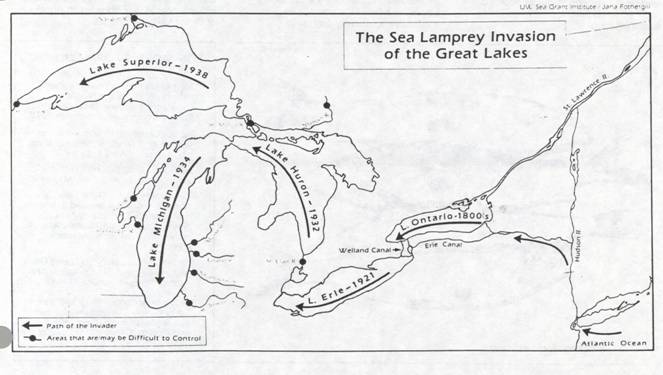
Sea lamprey movement timeline through the Great Lakes.
Negative effects on Great Lakes fish communities were quickly evident, and fisheries biologists were presented with a great challenge. In order to combat the invasion by the sea lamprey, they had to first understand how, where and when the sea lamprey reproduced and when during its life cycle, it was most susceptible to control practices.
The Sea lamprey
Sea lamprey have a two-part life cycle: an adult stage and a larval stage (see Figure 2). Adults live and feed in the lake and return to streams to spawn. An average female sea lamprey deposits 68,000 eggs in one spawning season, but any single female can deposit anywhere between 24,000 to 107,000 eggs per season.
Figure 2 - Life cycle of the Sea Lamprey
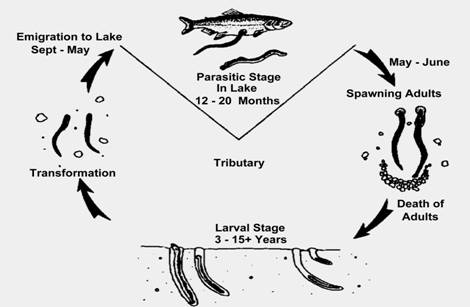
Illustration showing sea lamprey life cycle.
Spawning
The spawning phase of the adult lamprey begins in late winter and early spring. The parasitic adults congregate in bays and estuaries to prepare for upstream migration from the lake into tributaries for spawning. During this time, the body of the adult lamprey goes through several changes. The sex glands grow enormously, but the digestive tract begins to shrink as the lamprey quits feeding, directing all of its energy toward spawning. As the lamprey begins to live solely on stored body fats, portions of its body begin to deteriorate, and it dies shortly after spawning is complete.
Research suggests that certain criteria attract sea lampreys to particular spawning streams. The initial factor is likely to be the volume of water flowing out of the stream and the extent to which this plume of water reaches into the main lake. Adult sea lamprey may also key in on streams that contain large numbers of juvenile sea lampreys, which give off an odor or pheromone, that attracts the adults. Water temperature also plays an important role, and active spawning migrations into streams on Lake Superior's south shores typically begin in April, when the water reaches approximately 40°F.
Migrating adults search out a preferred spawning substrate of gravel or rubble that usually contains some sand. When the site is selected, the male begins to clear the area in which to build a nest. The female soon joins him, and both clear an area about two to three feet in diameter by picking up the small stones and piling them on the downstream side of the nest in a crescent shape.
Sea lamprey spawning peaks at 50°F, with the female depositing a few eggs, the male fertilizing them and both lampreys then stirring up a cloud of sand to cover the eggs. This spawning activity continues at intervals of about one to five minutes and may last from one to three days. All of the eggs will eventually end up being buried under the sand in the gravel rim of the nest. After spawning, both adults will die, many after migrating back to Lake Superior.
The time it takes for the fertilized sea lamprey eggs to hatch depends upon water temperatures. Typically the eggs will hatch in ten to twelve days at temperatures of 59-77°F, and on average, only about 6.3 percent of the eggs will successfully hatch.
Larval stage
The hatched larvae, called ammocoetes, are approximately 1/4-inch long and remain buried in the sand and gravel. When water temperatures reach 60°F, they emerge and drift downstream to burrow in the sand or silt bottom of a calm water area.
Ammocoetes are blind and harmless during this stage of their life, and they feed by straining food from the water passing over the burrow. The larval stage lasts anywhere from 3 to over 17 years, but in the Brule River this usually lasts four years. During this stage, they may continue to drift downstream and may even move into the river's delta.
The next period in the larval sea lamprey's life, called transformation, begins in mid-July. During transformation, the larvae develop large prominent eyes, a round mouth lined with sharp teeth, and a file-like tongue (see Figure 3). By October, the transformation is complete and the larvae are four to seven inches long. They then emerge from their burrow and move downstream during periods of high stream flow in late fall or early spring and out into the lake to begin their parasitic life as an adult.
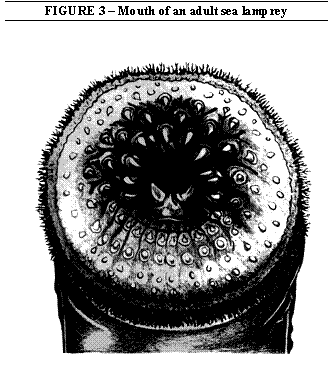
Illustration showing the mouth of adult seal lamprey.
Adult stage
As parasitic adults, sea lamprey prey on other fish. Adult lamprey typically select larger host fish, but since the fish does not recognize it as a predator, the lamprey is able to swim right up to it and attach by suction with its sucker-like mouth. Initially, the lamprey attaches to the fish anywhere it can, and it may not feed at the first area of attachment. It will usually migrate to the host's lower side at an area between the pectoral fins closest to the heart cavity (see Figure 4). When the lamprey finds a spot to feed on, a hard, cornified tongue rasps a hole into the side of the fish's body. The lamprey then secretes an anticoagulant to prevent the fish's blood from clotting, and nutrients are then derived from the various body fluids of the prey fish.
Laboratory studies indicate that adult sea lamprey feed on several fish during its lifetime. This theoretically accounts for some of the rapid distribution around the lake as they ride along with their hosts.
Laboratory studies have also determined that females attack more often, feed more frequently, and grow to a slightly larger size than males. The average size of adult sea lamprey returning to the Brule River is about 18 inches, but individual sizes can vary year to year due to changing lake and river conditions.
In captivity, the average lamprey has been shown to kill 18.5 pounds of fish during the adult phase of its life cycle. Researchers have estimated that sea lamprey in the wild are likely to kill twice that of the less active, lab held specimens or about 30 to 40 pounds of fish during the twelve to twenty months spent feeding in Lake Superior.
Figure 4 - Adult sea lamprey attached to a lake trout. The preferred area of attachment is nearest to the heart.
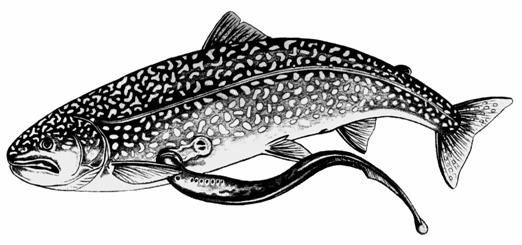
Illustration showing adult sea lamprey attached to a lake trout.
Effects of rising sea lamprey populations on Lake Superior fish populations
From the 1930s to the 1950s, the Lake Superior commercial fishing industry was a multi-million dollar industry. However, the rapid spread of sea lamprey and the subsequent reductions in fish populations due to lamprey predation nearly reduced the industry to nothing. Commercial lake trout harvests declined from 1,813 metric tons in 1953 to only 188 metric tons in 1961. During this same period, the number of sea lamprey caught in index streams increased from 1,780 to over 69,000 (see Figure 5). Estimates based on data collected during laboratory experiments would indicate the number of adult sea lamprey captured during this nine-year period could have destroyed as much as eight million pounds of fish in Lake Superior.
Figure 5 - Commercial harvest of lake trout, 1930-1966 (broken line) and the number of sea lamprey caught in mechanical/electrical weirs, 1953-1969 (solid line)
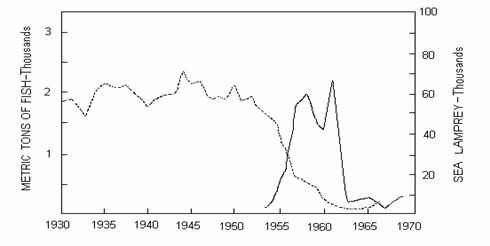
Graph showing metric tons of trout vs thousands of sea lamprey.
Wisconsin DNR Illustration
The effects of sea lamprey predation were also evident in fish species other than lake trout. Steelhead, a rainbow trout that spends part of its life in Lake Superior, was another species that appeared to be affected by the sea lamprey. Lamprey scarring rates of 1.5 percent of 1,300 mature steelhead captured in 1956 increased to 13.6 percent of 1,078 fish examined in 1960.
Other species that showed some effects of lamprey predation were the burbot, which declined concurrently with the lake trout, and lake whitefish, which showed high scarring rates from 1954 to 1960. (Figure 6) In addition, sea lamprey predation has been observed on almost all other large species of Lake Superior fish.
Figure 6 - Sea Lamprey scars on lake whitefish
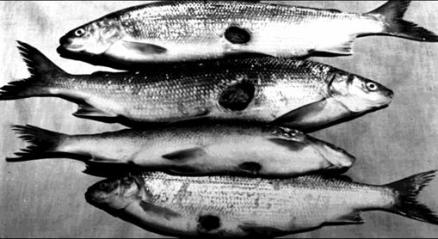
Sea Lamprey can make large scars as seen on these lake whitefish.
Methods for controlling sea lamprey populations in Lake Superior
By 1950, sea lamprey were reproducing in 117 U.S. and Canadian streams that flowed into Lake Superior. It was becoming apparent that methods for control or eradication of this pest needed to be developed.
The first step in the control effort was to try and establish exactly which streams were being heavily used by sea lamprey as spawning and rearing areas, and then the actual control techniques could be developed. During 1950 and 1951, four mechanical or screen-type weirs were installed in streams along the south shore of Lake Superior in an attempt to block lamprey runs. In 1960, 97 electrical barriers and also some blocking devices, were installed in streams with heavy or moderate sea lamprey use (see Figure 7).
Figure 7 - Brule River electrical weir which was in operation from 1960 to 1978
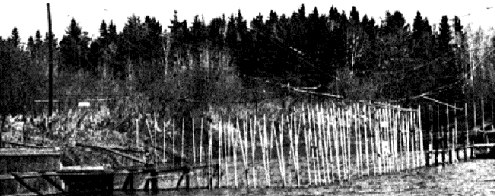
Brule River electrical weir.
This type of barrier, or weir, consisted of parallel electrode arrays that were charged with 115 volts AC (alternating current) stretching from bank to bank. This would render a fish unconscious as they attempted to move upstream through the array, but it did cause mortality in some trout and salmon. To combat this problem, DC (direct current) diversion fields were added on the downstream side of the weir. Because fish are drawn to the positive end of the electrical field, anything swimming upstream would be drawn into strategically placed mechanical traps. When the traps were emptied, the lamprey was removed and destroyed while other fish were removed and placed upstream of the barrier.
Of the original 55 weirs operating specifically as devices to control the sea lamprey population, 24 would eventually only be used for monitoring changes in the numbers of spawning migrants from year to year. By 1966, only 16 electrical weirs were in operation and being used solely as index mechanisms to monitor yearly spawning runs, including the one on the Brule River.
The electrical weirs were not effective in reducing the sea lamprey populations, and there were many problems associated with them. Electrical weirs could potentially block almost all adult sea lamprey from spawning, but not without high electrical costs and physical harm to trout that use the same river for their spawning. The mortality of steelhead at the Brule River electrical weir in 1977 highlighted this problem. There were 1,436 steelhead trapped that year, and 106, or 7.4% were killed. It was becoming obvious that a more effective approach was needed, and electrical barriers were essentially phased out with the development of more effective control techniques.
During the 1950s, while electrical barriers were in use, other means of controlling sea lamprey were being researched. The target of research centered on the more vulnerable stages in the lamprey's life cycle, one of which was the juvenile, or ammocoete stage. It was thought that chemicals that had been used successfully to combat mollusks during their larval stages could also be used in the fight against sea lamprey.
In 1958, 3-trifluoromethyl-4-nitrophenol, or TFM, was adopted for use in combating sea lamprey in streams. It was developed specifically for use against the ammocoete stage of the sea lamprey, and additions of the molluscicide Bayer 73 helped to increase the toxicity and reduce the amount of TFM needed. An accurate TFM treatment procedure would be necessary in order to reduce the potential hazardous effects to other species of fish.
The U.S. Fish and Wildlife Service developed a methodology for TFM stream treatment that begins with an intensive survey of the stream using stream-shocking units to first determine the location and distribution of the ammocoetes. This information and a detailed map of the stream can then be used to develop a chemical distribution plan.
Just before treatment, a complete study of the stream is carried out to determine the minimum concentration of TFM needed to kill the ammocoetes as well as the maximum concentration that could be used without adversely affecting other fish species present in the stream. Finally, the lampricide is introduced into the stream via an accurate dripping process for a length of time necessary to ensure the minimum concentration indicated by the study is reached.
The first full round of TFM treatments of Lake Superior streams began in 1958. Twelve streams were initially treated, and 10 of those were considered successful. An additional 60 streams were treated during 1959 and 1960, and only four had to be retreated due to poor results.
Presently there are 55 lamprey-producing streams in the U.S. waters of Lake Superior. Thirty-four of these are primary producing streams, such as the Brule River, and are treated every three years. The other 21 are secondary producing streams, which are only treated every six years.
Decreasing federal funding and the steadily rising cost of TFM, which is only manufactured in Germany, have combined to make this treatment process a more expensive one every year. In 1986, TFM could be bought for $8.39 per pound. Three years later, in 1989, the price had risen to $14.50 per pound. By 1995, the price of a pound of TFM had reached $23.55 per pound.
Along with the problems of increasing chemical costs, TFM treatments can also be detrimental to some other animals living in the stream including trout, perch, logperch, bullheads, stonecats, channel catfish and mudminnows. Other species like white suckers, longnose suckers, trout and salmon that are already stressed due to spawning are also susceptible. TFM also affects invertebrates such as certain aquatic earthworms and mayfly larvae. Tadpoles and other amphibians are also susceptible but not usually present at treatment time.
Over the years, TFM treatments have had a significant impact on the sea lamprey population. By 1961, there were a reported 50,975 lamprey caught in the stream weirs. After TFM treatments began, the number of lamprey caught in the weirs dropped by 86% to only 7,303 lamprey in 1962. Numbers continued to steadily drop over the next decade, and by 1978, numbers had fallen to only 8% of the pre-control average. The Brule River electric weir, which averaged 14,039 lamprey caught each year before TFM treatments began, was now averaging only 930 lamprey per year.
Recently, estimates of the total number of sea lamprey in the Great Lakes have been calculated through a mark and recapture study conducted by The U.S. Fish and Wildlife Service. From 1986 to 1990, the total population in the U.S. waters of Lake Superior averaged 42,457. From this, we can see that the sea lamprey abundance has declined significantly from peak levels in the late '50s and early '60s. However, even at present reduced levels, they are still one of the largest mortality factors for Lake Superior fish. Continued TFM treatments can only maintain the reduced population, but they could be reduced further with the implementation of newer control methods that are currently being used and researched.
One of the new methods currently being studied is a sterile male program that has proven successful in controlling certain insect pest species. The sea lamprey sterile male program was initiated along the U.S. Shorelines of Lake Superior in 1991. The program began by trapping male sea lamprey early in the year, sterilizing them, and then releasing the 20,000 sterilized males into 21 Lake Superior tributaries.
Despite the fact that they are sterilized, the males still carry out their spawning behavior, and both lampreys are fooled into thinking they have successfully spawned. The eggs, however, are not fertilized and will never fully develop which reduces the sea lamprey's reproductive success. This program is also helpful in larger rivers such as the St. Mary's and St. Louis, which are too large for effective TFM treatments. A release study program instituted in 1988 indicated that 93% of captured and released lamprey males were recovered within 50 miles of the release area.
Another control method now in use is the construction of permanent low-head dams at locations near the mouth of rivers being used by sea lamprey. The dams act as barriers, which reduce the length of stream available for lamprey spawning and rearing. Since many streams on the north shore of Lake Superior have natural barriers in the form of waterfalls, low-head dams were not necessary. Lake Superior's south shore streams do not have natural lamprey barriers, and so construction was focused on south shore streams.
The Middle and Brule Rivers in Wisconsin are two such streams on which low-head dams were constructed. The Middle River was designated for the construction of a permanent barrier in 1981. An area of rapids just upstream from Highway 13 was selected for the site because of the bedrock base and easy access from the highway. The five-foot concrete dam was built with an overhanging metal lip that creates a dead air pocket under the waterfall. The pocket makes it impossible for the lamprey to ascend the barrier face, therefore preventing them from migrating further upstream. The waterfall is high enough to stop sea lamprey while still allowing trout and salmon passage during adequate flow periods.
To further increase its effectiveness, traps are also placed on either side of the barrier to capture the lampreys that make it up to the dam. These traps, however, will not capture lamprey that stop short of the barrier, so spawning can still potentially occur downstream of the dam. The Middle River barrier has been in operation since 1983.
The Brule River sea lamprey barrier and fishway
Estimates by the Great Lakes Fishery Commission showed that between 30 and 50% of all sea lamprey captured on U. S. tributaries of Lake Superior between 1973 and 1978 were caught in the Brule River. The Brule River provided such a substantial amount of sea lamprey spawning habitat that it was the next stream chosen for the construction of a permanent low-head dam.
The Wisconsin Department of Natural Resources began the site selection and preliminary design work in 1980, but a suitable site and design were not selected until 1983. Kleppen's Falls, an area approximately six miles upstream from Lake Superior, was finally chosen as the barrier construction site for several reasons. With the barrier relatively close to the mouth of the river, TFM would only need to be used on about 9.4 miles of the stream as opposed to the over 80 miles before the dam. It was also ideal because the area contained on a pre-existing vertical drop that was situated on solid sandstone bedrock, and the area behind the falls would not create a substantial dead water area, even when impounded.
Construction of the Brule River barrier was funded by Wisconsin Great Lakes Trout and Salmon stamp funds at a final cost of $149,000, and the dam was completed in September of 1984. It was a basic low head dam with a metal lip, which was designed to stop sea lamprey from moving farther upstream. A fish ladder consisting of two jumping pools provided access to the upper river for migratory trout and salmon, but water velocity going through the fish ladder would be too great for sea lamprey to swim through.
Upon completion of the dam, fisheries personnel were anxious to see how well trout and salmon swam through the fishway. Unfortunately, due to problems in the design, fish were not able to swim through the fishway during all water conditions. Modifications were made which allowed many fish to pass, but free passage of fish under all conditions could not be achieved.
Complaints from fishermen and concerned citizens prompted the Department of Natural Resources to consider either rebuilding the structure or removing it and returning the site to its original form. Public meetings were held, and Wisconsin DNR personnel consulted fishery personnel from other states and Canada. Wisconsin DNR engineers went to work and came up with a new, more workable design that was approved at a public meeting in the town of Brule.
Construction of the new design began in the summer of 1985. About 2/3 of the barrier, including the jumping pools, was removed. The total cost for the construction of the new fishway was $238,000, which was paid for by the Great Lakes Fishery Commission and Wisconsin's Great Lakes Trout and Salmon stamp fund. The new fishway was completed in March of 1986 and consists of a low-head dam obstructing 3/4 of the stream and a fish ladder spanning the rest of the stream.
As fish and sea lamprey swim up the river, they encounter artificial riffles in the stream that force them to swim towards the entrance of the fishway. The fishway contains six steps, each consisting of a waterfall and a resting pool. Upon entering the fishway, the fish and lamprey swim over the first three waterfalls and then reach a moveable gate with an overhanging metal lip. This adjustable waterfall, which is raised or lowered according to water temperatures and conditions, is used to stop sea lamprey while still allowing trout and salmon to easily jump it and continue upstream through the fishway (see Figure 8).
Figure 8 - Overhead illustration of the Brule River lamprey barrier and fishway
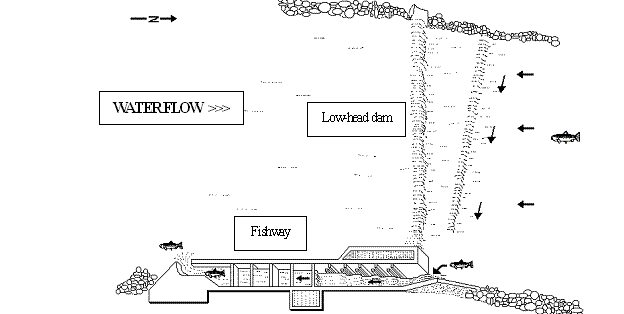
Overhead illustration of the Brule River lamprey barrier and fishway.
The sea lamprey, which cannot cross over the waterfall, is instead diverted into a fish trap. Metal funnels prevent larger fish from entering the trap and once captured, the lamprey cannot escape. Department personnel can then remove the lamprey, which is either disposed of or used in mark-and-recapture studies or sterile-male spawning programs.
The trout and salmon that continue over the waterfall and through the fishway then encounter two larger pools, which are used to control the amount of water flowing through the fishway. After passing through the two pools, they enter the narrows of the fishway. Here they swim past a 4-foot tall and 3-foot wide observation window where a video camera records everything that swims through the fishway. To assure that fish passage can be monitored through turbid water periods, a moveable deflector gate is used to force the fish to swim very close to the window.
Just upstream from the window and past a metal "trash rack", which stops large debris from entering the fishway, is the fishway exit. The fish then swim through the rack and enter the river upstream of the entire structure.
Since the fishway was constructed to allow fish passage year-round, it requires a different configuration for fish passage in both warm summer and icy winter conditions. The ladder configuration, consisting of waterfalls and resting pools, is used from ice-out in spring through ice-up in fall. During winter, when ice would form on the water's surface and freeze the falls, a vertical slot configuration is necessary.
In this configuration, the waterfalls are blocked off and vertical openings in the fishway are opened which allow for water flow and fish passage even in ice-covered conditions. The gate that normally creates the adjustable waterfall is raised off the floor of the fishway to allow water and fish to pass under it.
Stop-logs are placed in grooves behind the "trash rack" at the upstream opening to the fishway to allow water to be drawn from under the layer of surface ice. This configuration causes water to flow through the fishway in swirling circular patterns, which prevents the fishway from completely freezing and allows fish passage through winter.
There is also an auxiliary fishway just west of the main fishway which consists of three steps carved out of the natural bedrock base of the river. Large stop-log sections in the low-head dam can be removed to allow flow through this "emergency fishway" if the main fishway had to be shut down for any reason. A canoe portage on the west side of the river provides safe access around the low head dam for river explorers and anglers.
The fishway was completed and became fully operational on March 27, 1986, and the first fish passed the observation window soon after. On May 5, that same year, the first sea lamprey were captured in the fish trap, and on May 27, department personnel trapped and removed 2,142 adult sea lamprey, (see Figure 9), thus preventing them from reproducing. A graph illustrates the number of sea lamprey captured at the Brule River Lamprey Barrier from 1986 to 2007 (see Figure 10).
Figure 9 - A catch of 2,142 sea lamprey at the Brule River Barrier trap in 1986
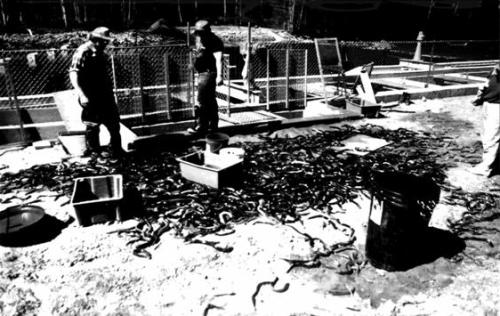
Sea lamprey caught at the Brule River barrier trap.
Besides allowing for the trapping and removal of the sea lamprey, the barrier and fishway also has another important function. The observation window at the upstream end of the fishway allows the Department of Natural Resources personnel to count the number of anadromous salmonids that ascend the river each year to spawn. This information provides an extremely important management tool for the Brule River fishery.
From 1986 through 1988, two observers were used to count fish passing the window. Counting would begin shortly after ice-out in early spring and continue until ice up in winter. Each observer worked five randomly selected, eight-hour shifts per week, which covered roughly 40% of the total possible observation time. This data was then expanded to produce an estimate of the total salmonid passage by week. This system worked well but left room for improvement of accuracy.
In the summer of 1988, donations from the Brule River Sportsmen's Club and the Lake Superior Steelhead Association paid for the installation of a video camera and a time-lapse videocassette recorder. By using the video system between observer shifts, an almost exact count of fish movement became possible. The video system proved so reliable in 1988 and 1989 that the use of human observers was discontinued.
Figure 10 - Brule River Fishway sea lamprey catches
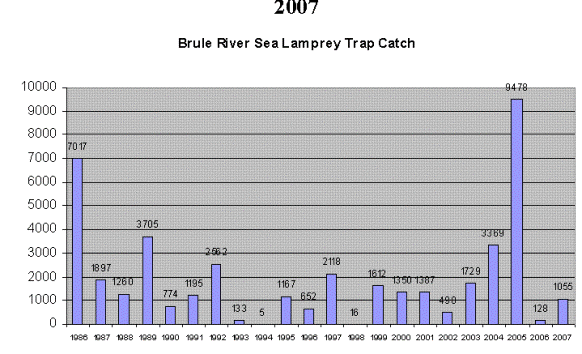
Graph showing numbers of sea lamprey caught at the Brule River Fishway 1986-2007.
The original video system used an 8mm black and white time-lapse recorder and camera, but further donations would soon allow for an upgrade. Sport clubs including The Brule River Sportsmen's Club, The Lake Superior Steelhead Association, The Western Lake Superior Trolling Association, and the Douglas County Fish and Game League helped fund the addition of two color VHS time-lapse recorders, a color camera, and a color monitor. The color VHS setup improved species identification accuracy and allowed for longer recording periods.
During fall observations in 1986, it was noted that fish movement seemed to cease when water temperatures drop below 35o F. During the winter of 1989-90, the video system remained in operation throughout the winter. During this period it was found that very few fish pass under ice cover in winter. Presently, the video system is in operation from ice-out in the spring to freeze-up in winter.
The lamprey trap also provides the opportunity for DNR personnel to sample trout and salmon during their spawning runs. By installing a larger entrance funnel into the fish trap and running the maximum flow possible through the trap, simulating natural river conditions, fish are more likely to be drawn to the trap for capture. Once captured, fish can be tagged, scales can be collected for aging, and information such as species, length and weight can be recorded if desired. The estimates of the annual salmonid passage by species are compiled in Table 1.
This unique fishway on the Brule River has proven very effective as both a method of controlling sea lamprey and as a tool for monitoring the health of the river's anadromous fishery. The effectiveness of this structure is also being studied during the Department's spring lake trout assessment of Lake Superior when lamprey-scarring rates are examined.
Anadromous fish runs
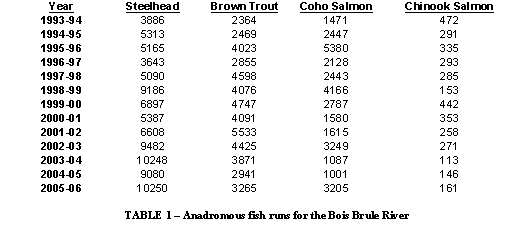
Chart of anadromous fish run numbers on the Bois Brule river 1993-2006.
References
Becker,G.C. , Fishes of Wisconsin. University Press, Madison, WI. Pp 211-215, 1983.
Ebener, Mark P. , Sea Lamprey Wounding Rates in Lake Superior - 1988. Great Lakes Indian Fish and Wildlife Commission, Odanah, WI, 1989.
Halloway, Gale and Bishop, Jim, Lamprey Barrier a Story of Persistence. Wisconsin Natural Resources vol. 11, No. 3, May/June 1987.
Smith, Bernard R. , Sea Lamprey in the Great Lakes of North America. The Biology of Lampreys, vol. 1, M.W. Hardisty and I.C. Potter (ed). Academic Press, New York, 1971.
Smith B.R. and Tibbes, J.J. , Sea Lamprey in Lakes Huron, Michigan, and Superior: History of Invasion and Control, 1936-78. Canadian Journal of Aquatic Science, vol.37, pp. 1780-1799, 1980.
Great Lakes Fishery Commission - Special Publication No. 85-6,1985, TFM vs. Sea Lamprey: A Generation Later.
Originally written and compiled by William Gobin, Wisconsin Department of Natural Resources. Assisted by William Newton, Joel Accola and John H.Downs.
Edited and revised by Darin Gossett, WI DNR Western Lake Superior Fish Management Team, December 2003.
